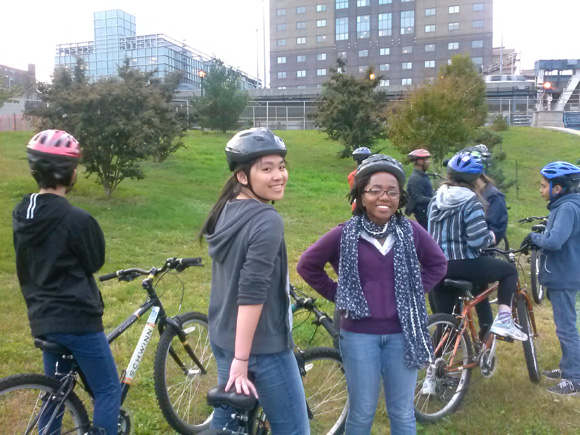Mike Dowd is a social studies teacher at Brooklyn's Midwood High School.
Last fall, at the high school where I teach, I was approached by some 12th-grade boys looking to start a cycling club. As a long-time bike activist, I was thrilled to help. But after our first few meetings, problems arose. At our school, seniors finish the day much earlier than I do, and a new semester brought scheduling difficulties. Interest started to drop and the club appeared ready to fold.
I hated to see this happen, so I decided to try to recruit from the younger grades. My hopes weren't high, as I had never noticed much interest in cycling among our students. But I was quite mistaken. Not only has the club continued to exist, but the enthusiasm it has generated has changed my thinking about how to create a more bike-friendly city. I now believe that promoting youth cycling is a crucial missing component in the movement for livable streets.
Despite my modest recruiting efforts, more than 30 new students attended our club's next meeting. To my surprise, the vast majority were girls, few were regular cyclists, and many didn't own a bike or had never learned to ride. But for whatever reason, they seemed interested in the club.
The problem was, I had no idea what to do with these kids and no guidance from the Department of Education as to what was permitted. Over the next few weeks, as I searched for ideas and advice on how to get them on bikes, new students kept coming to our meetings.
Fortunately, I found Bike New York, whose free after-school riding classes in Brooklyn Bridge Park perfectly matched our needs. They offered group riding skills for those who knew how to ride and basic lessons for non-riders. Even though they were located far away and their classes conflicted with many of our members' other commitments, we had more than enough students to fill a class.
As I watched nervously the first day, things appeared to be going well. Though the initial drills were fairly simple, the kids seemed excited just to be on bikes. In fact, one girl offered some very high teenage praise, when she whispered to me during a break, "This isn't as boring as I thought it would be." Later, as the group returned from a short ride, another girl said, "I'm so glad I joined this club. I haven't felt this happy in years!" I was bowled over.
As the school year ended, the classes continued with great enthusiasm. I was very proud of our group, especially those who had learned to ride for the first time. Yet the scope of our success was limited. The kids were enthusiastic about riding but couldn't pursue their interest over the summer. Though they were eager to continue with supervised rides, they weren't ready to hit the streets on their own, nor did they necessarily own bikes.
Furthermore, as school began this fall, I had to avoid publicizing the club too much. Just through word of mouth, I now have more interested students than Bike New York can accommodate in one class. Students continue to approach me about joining, but I don't know what to do with them. A few are taking repair classes at Recycle-A-Bicycle, but space there is limited, too. And now that our fall riding classes are over, we have to wait until spring to ride again.
At the same time, our limited successes have given me great hope. I now realize there is a huge latent demand for cycling among young people. If advocates can figure out how to meet this demand, the movement for safer streets will have much broader support.
My students tend to come from communities that are underrepresented in the world of bike advocacy. Most are girls, most are from immigrant families, and most live in southern Brooklyn. Their neighborhoods tend not to have much cycling infrastructure. We need to tend to their interest in riding if we want better cycling conditions to extend throughout the city.
This should not be a daunting task. One potential model is Beat the Streets, a foundation run by former wrestlers that funds middle and high-school wrestling programs in city schools. In just a few years, they've turned a sport that barely existed in the city into one with a major presence. A few deep-pocketed cyclists could probably make a similar impact.
But I don't think we need to rely on private donors to make this happen. The city already has a budget to provide physical education to teenagers. There's no reason cycling can't be part of the curriculum. Many schools, short on gym space, already have offsite classes. My school, for instance, offers bowling and billiards at outside locations.
Imagine cycling centers in locations like Floyd Bennett Field and Flushing Meadows Park offering afternoon, weekend, and summer classes. This wouldn't require anything complex or expensive. Bike New York operates classes using just a large tent for instruction and a few lockers for bike and helmet storage. If the city were willing to pay for instruction, perhaps private money could help fund some of the overhead and supplement the in-school classes with other activities, like group rides.
There's no doubt that Mayor Bloomberg has been transformative in making our streets safer for biking. But if the mayor wants to cement this legacy, he needs to broaden support for bike infrastructure. The best way to do this would be to nurture the next generation of bike activists, especially in neighborhoods where cycling has yet to take hold. In doing so, he'd be creating a constituency for a greener, healthier city for generations to come. Trust me, our kids are waiting to be engaged.






